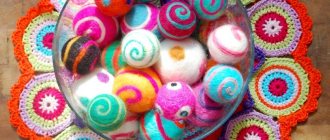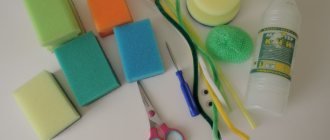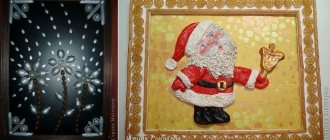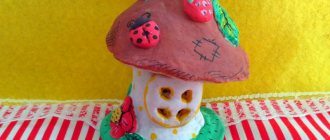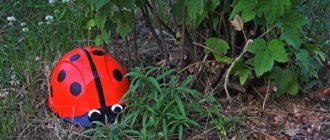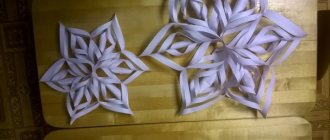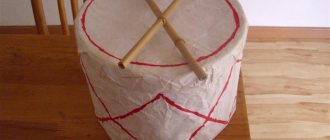What seems natural and understandable to an adult needs to be explained to a child. A striking example of this is the seasons. The easiest way to talk about what features are characteristic of each of them, what changes are taking place in the world around us is to use the example of a handmade craft. As the work progresses, the child will not only learn a lot of new things, but will also go through each “step” from winter to autumn, and will better assimilate the information presented in a playful form.
Cardboard tree with seasons
A layout of such an unusual shape can be used not only as a theme for classes in school or kindergarten, but also as teaching material.
For this craft you will need:
- corrugated cardboard (containers for goods from the store);
- scissors, pencil, ruler;
- PVA glue and water, napkins;
- acrylic paints and brushes for them;
- felt decor.
You can make decorative elements with your own hands or buy ready-made animal figurines, flowers, and foliage at a craft store.
Let's start creating the base of the tree. We first cut out the template from newspaper, then transfer it to cardboard and cut it out again.
On the parts we make cuts up to the marks - on one from the bottom to the middle, on the second from the top to the middle. We “put” the elements on top of each other.
Now you need to install the tree on a round base. To do this, we bend the “legs”, remove the corrugated part of the cardboard, and glue the bent part to the round blank, the base of the “Seasons” craft.
You can start finishing the wood. To do this you will need napkins, water and PVA glue. We dilute the glue in a large container with water at the rate of 1*1, moisten napkins in the solution and use them to cover the base with your own hands on all sides, including the stand.
Using acrylic paints we paint the seasons on each side of the craft - winter, spring, summer and autumn.
The last step is decor. As we decorate, we explain to the child what changes are happening in nature, how animals behave, for example, a bear sleeps in winter, birds that have flown south return in the spring, etc.
Step-by-step video tutorial for making the “Seasons” tree:
Master class on making a manual for a corner of nature “Miracle Tree”
Marina Andreeva
Master class on making a manual for the corner of nature “Miracle Tree”
Miracle Tree - a guide for decorating a corner of nature in a preschool educational institution
Completed by: teacher Andreeva M.A.
The purpose of creating the manual: to observe the changes that occur in nature in different seasons of the year, how a tree changes with the seasons. This miracle tree promotes the effective formation of ideas about the seasons:
• familiarization with seasonal changes in nature;
• review and discussion of changes that have occurred;
• writing descriptive stories;
• orientation in space: above - below, right - left;
• familiarizing children with color, shape, size; tangible properties of objects (hard, soft, fluffy); materials;
• development of the ability to highlight the properties of objects, group homogeneous objects according to several characteristics;
• activation of the dictionary (D/games “Name the parts of the tree”, “Who has arrived?”, etc.);
• improving the grammatical structure of speech and coherent speech.
Materials: Whatman paper, self-adhesive film in 2 colors “Milanese walnut”, “dark wenge”, a simple pencil, scissors, Velcro, titanium glue for attaching wood to the wall.
Size: height 1 meter, width 60 cm
Manufacturing:
1. On whatman paper (you can take a piece of wallpaper on the back white side) draw a random tree.
2. Cut out the template.
3. Glue the Milanese-colored self-adhesive film onto the template.
4. Add a hollow - glue a self-adhesive film of wenge-dark color in random stripes in a circle.
5. Add a nest - glue small stripes-twigs of self-adhesive film in dark wenge color.
7. We make blanks for decorating the tree according to the season - leaves: green (summer, orange, yellow (autumn), grass: on the roots of the tree, snow: from cotton wool or padding polyester (winter, flowers (spring, birds and animals. On all attachment elements - Glue Velcro onto the blanks.
8. We attach the tree to the wall in a corner of nature using titanium glue.
We admire the result and decorate the miracle tree according to the seasons together with our students!
Master class “How a miracle tree grows at our gate” Good day to all my guests. Finally, I have a moment and I can share with you a small master class. The fact is that. “Four Seasons” tree for decorating a corner of nature To decorate a corner of nature, I really wanted to make a “Four Seasons” tree. I searched the Internet, but I wanted to do something. A tree for a corner of nature in a group Almost every group has a corner of nature. And in order to make it unique and somehow diversify it, I suggest, in my opinion. Didactic game. Layout for the nature corner “Animals of the forests”. Master Class. Didactic game. Layout for the nature corner “Animals of the forests”. Master Class. Dear colleagues, I ask you to familiarize yourself with what I have created. A didactic guide to a corner of nature. Miracle tree “Four seasons - four seasons” Purpose: To form children’s ideas about seasonal changes in nature. Objectives: Educational: expand and enrich children’s ideas. Master class “Miracle Tree” for studying the seasons To show children the features of the seasons, I decided to make a “Miracle Tree”. To make it I needed: newspaper, scissors,... Master class on making a didactic manual on social-emotional development Dear colleagues! I bring to your attention a master class on making a manual on social-emotional development from wooden spoons. Master class on making crafts “Heart for Mom” For our “Heart for Mom” we will need: white cardboard, red cardboard, pencil, scissors. First we draw a silhouette on red cardboard.
Cylinder with seasons
Such a figurine, hollow inside, with openwork walls, can be used both as visual material in the classroom, for activities in kindergarten, and as a lampshade for a low-power lamp in a child’s room.
The craft is made from thick white cardboard. First you need to prepare the base. We cut out the workpiece - an oblong rectangle and divide it into 4 equal parts, drawing their boundaries with a pencil. In addition to the base, you need to prepare your own apple, birch, rowan and oak trees.
In each of the 4 parts we cut out “windows” - into them we will paste trees with signs of spring, summer, autumn and winter. We paint the “windows” in a color characteristic of each period.
Then we carefully assemble the cylinder - just glue it together.
Cube
To make an educational cube with the seasons, you need to prepare four applications with thematic pictures and the base - a cube template.
It is better to make applications together with the children, so that as you work, you can talk about each season in detail. We also draw and cut out the details of the appliqués together with the kids.
The base of the cube must be made strong. The best option is a corrugated cardboard box from a store. The size of the appliqués must correspond to the dimensions of one side of the geometric figure.
We paste the finished pictures onto the cube template, assemble it and fix it with glue.
All seasons on one application
Older children can themselves, without the help of adults, but under their guidance, make one voluminous applique, which will reflect all the seasons at once.
Before starting work you need to prepare:
- colored cardboard and paper;
- ruler, pencil;
- eraser and scissors;
- glue for paper.
The base will be a leaf of blue color, symbolizing the sky. The first thing we will stick on it is a trunk with branches cut out of brown paper.
We will start decorating in the fall. In autumn, yellow leaves fall from the trees. We cut them from paper of the appropriate color and paste them in the lower right part of the applique.
Summer means bright green foliage, ripe apples and bright sunshine. We place them above the autumn, also on the right side.
Spring is next. This season will require flowers. We will make them from red paper - we will cut the squares and bend them twice diagonally, straighten them a little and glue the voluminous buds to the tree in its upper left part. Let's add yellow bees with brown stripes on their bodies.
The last stage is winter. We cut out snowdrifts from white paper, “lay” them on the branches and the ground, and white round snowflakes will fill the space between them.
This master class can be used both at home and in a lesson in the lower grades or in classes in a kindergarten group.
Step-by-step job description
For the spring side, you can make a birdhouse and glue paper dandelion flowers.
The winter side of the craft can be decorated with snowflakes and figurines of Father Frost, Snow Maiden, and a snowman. Don't forget to glue the birds and the feeder (during the game, you can remind the children to take care of animals and to feed the birds in winter).
The autumn part of the tree can be decorated with colored leaves, animal figures, and forest gifts (mushrooms and berries).
To decorate the craft, you can use cut out fruits and leaves from cardboard, felt, ready-made plastic figures, small Kinder Surprise toys and other decorative elements. Often children themselves suggest decoration options. Let them use their imagination and creativity in decorating the sides of the tree to suit the season. You will be surprised at how kids can correctly arrange all the elements according to the seasons.
Tactile and didactic panel for kindergarten “Seasons”
Children acquire most skills after the words “I myself.” A panel with pockets, each of which contains hidden signs of a particular season, will help them study and remember the seasons. And you can make it from felt.
The panel will consist of two main parts - a felt tree sewn onto the canvas and 4 pockets at the bottom with images of the seasons. Winter will be symbolized by a snowflake, autumn by a yellow leaf, spring by a flower, summer by a red apple.
We cut out the tree from brown felt and sew it on a machine (it is better to use a zigzag stitch) onto a thick fabric that retains its shape well. As a basis for the panel, you can use several layers of dense fabric, quilted with each other.
Then we prepare the pockets and sew them to the bottom of the panel. It is recommended to treat the edges of the felt pockets with a satin ribbon - if actively used without such “protection” they will stretch very quickly and become ugly. We sew Velcro and small buttons onto the branches - we will attach decor corresponding to the chosen season to them.
We put yellow and burgundy felt leaves in the “autumn” pocket. Winter will be symbolized by snowflakes made from cotton pads and bullfinches made by hand. Summer means lush green foliage and ripe red apples, and spring means flowers.
All decorative elements must have a part with which they can be attached to the panel - Velcro or a loop to put on a button.
To make the parts voluminous, we make them from two layers of felt, laying between them a thin layer of filler - padding polyester, cotton wool or holofiber.
All that remains is to place the figures in the appropriate pockets and invite the children to play an exciting game - “Seasons”.
Tree “4 seasons” made of felt
You can make a didactic felt toy for individual lessons no less colorful and visual. The uniqueness of this craft is that it is completely safe and environmentally friendly. A tree made from natural materials will appeal to any preschooler. Children will find it interesting to decorate the crown of the tree in accordance with the proposed time of year. You can also guess the name of the season yourself based on the corresponding signs.
The principle of the toy is as follows: the corresponding parts (fruits, flowers, snowflakes, clouds and colored leaves) are glued onto the base-trunk. Children must independently select the appropriate tree decoration details that are characteristic of a particular season.
